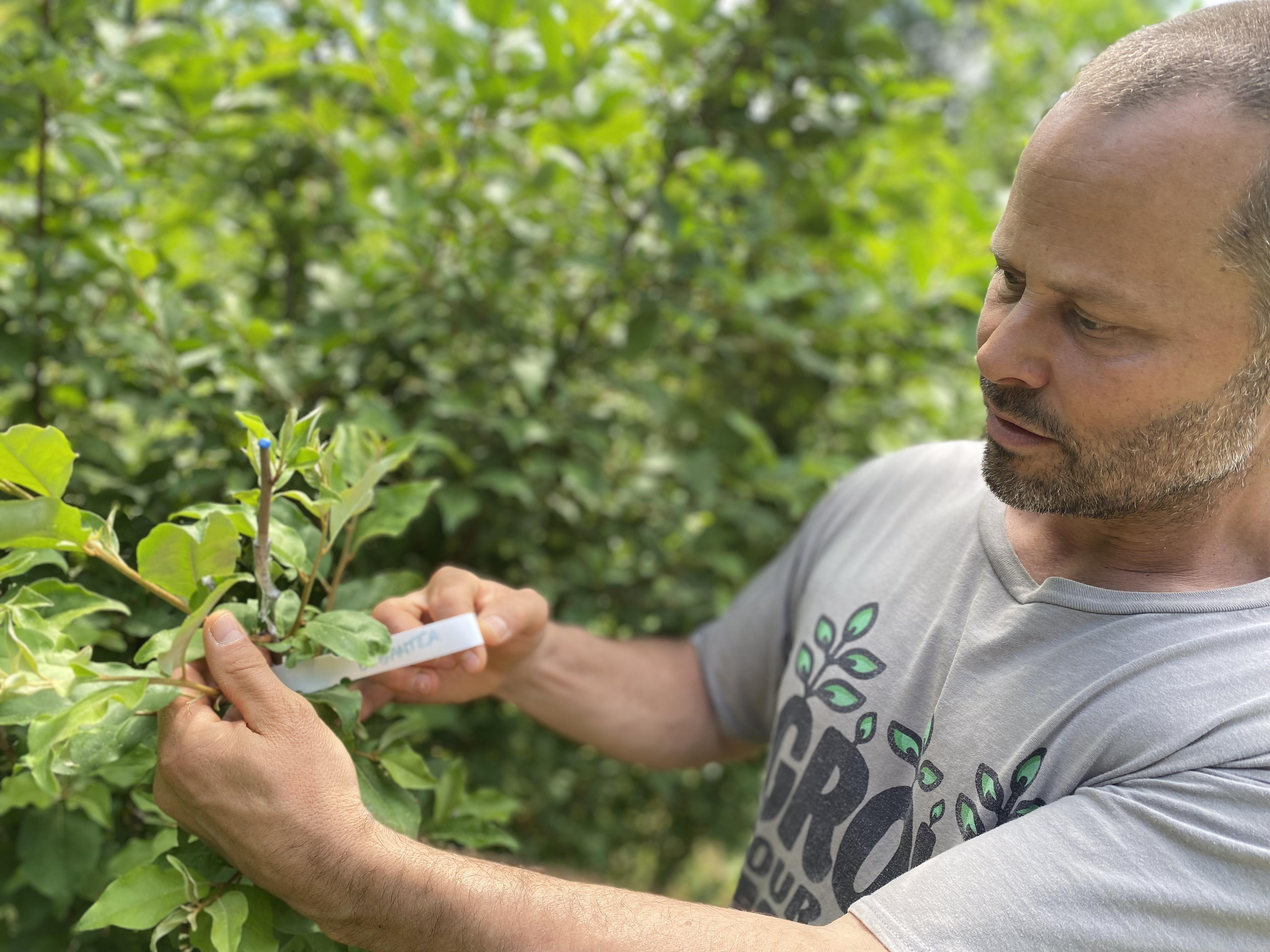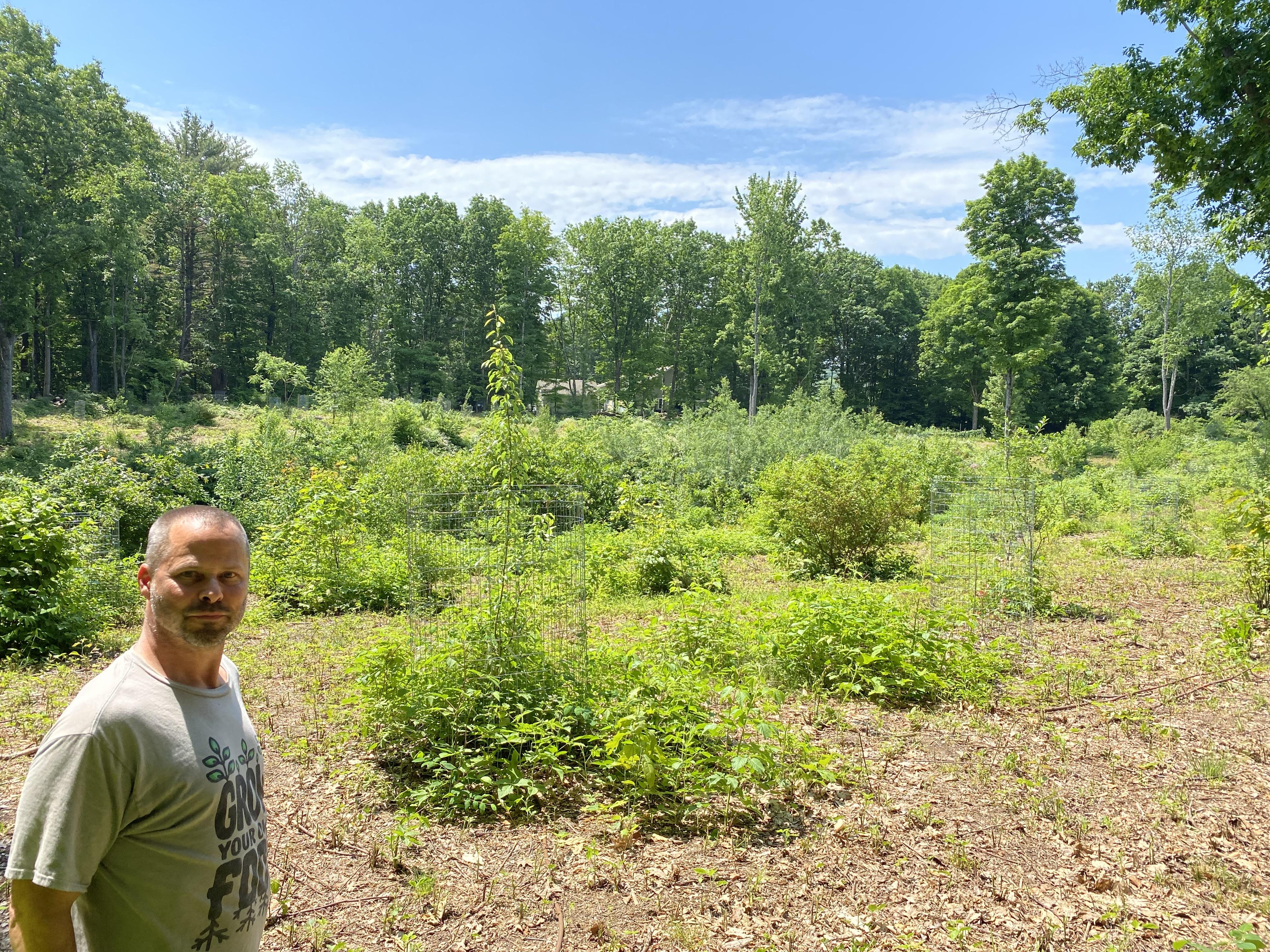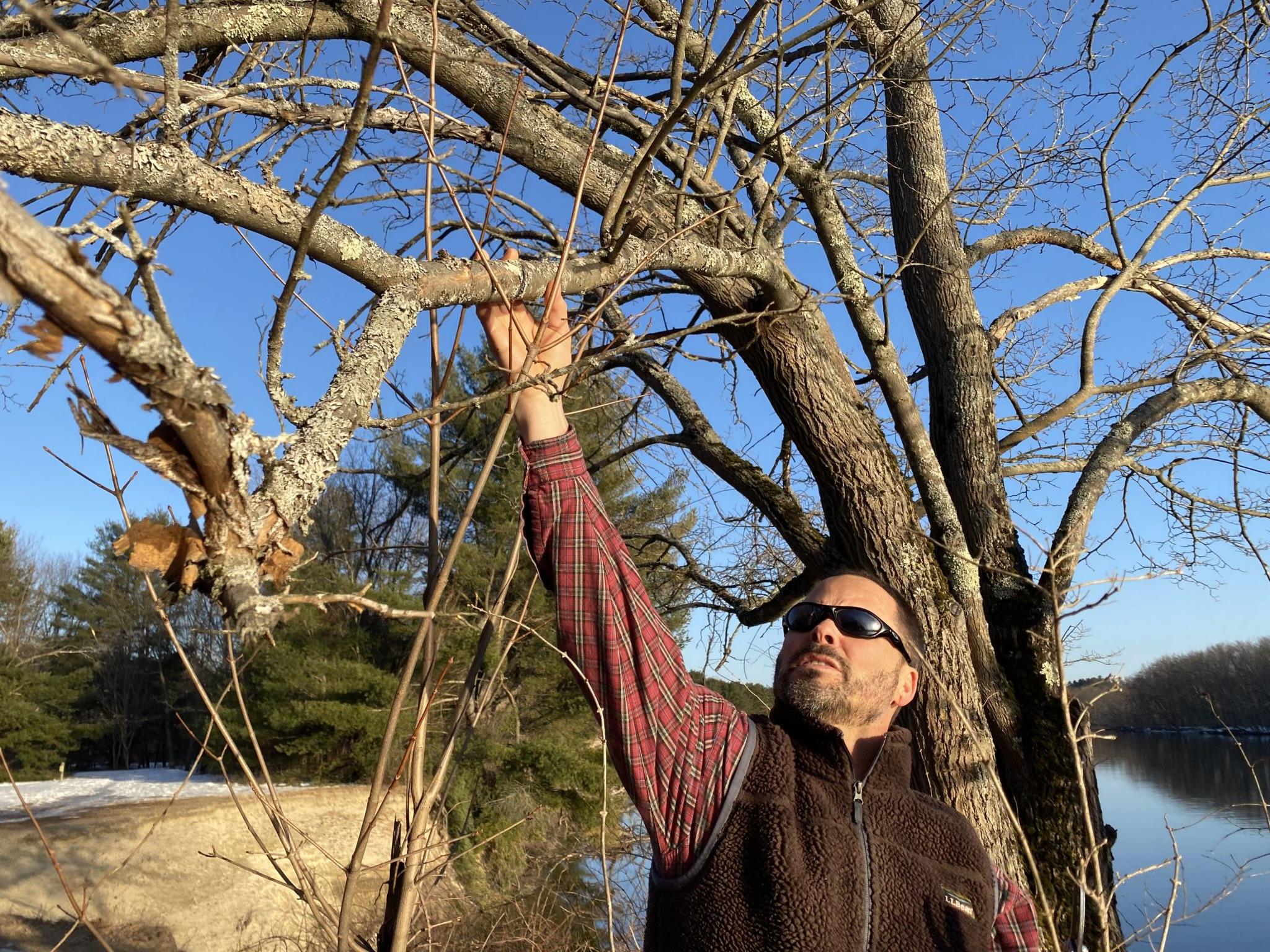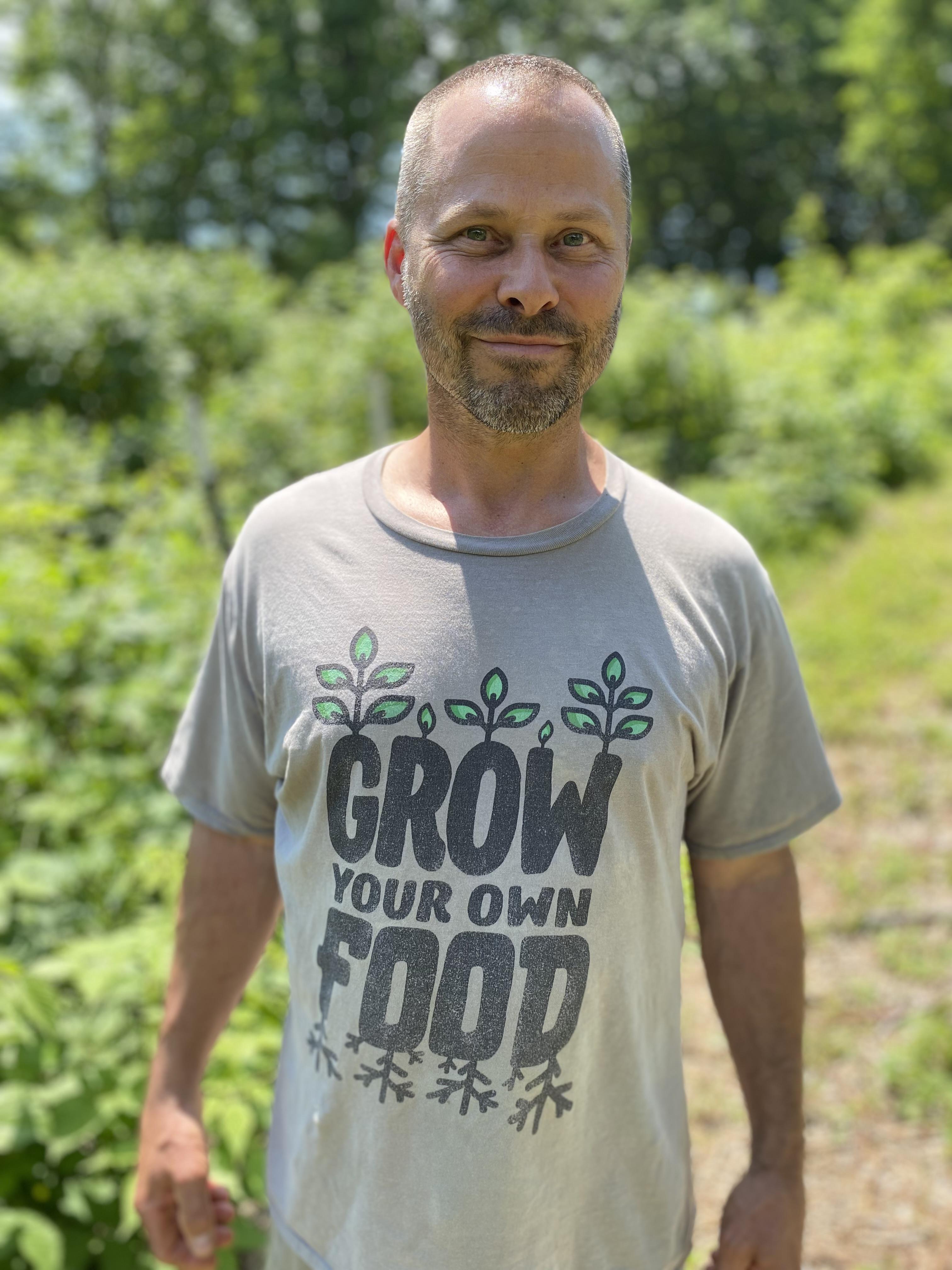
At “Applecroft Farm” in Dunbarton, Bill Wardwell is adamant: “More people will need to be able to grow more of their own food.”
Wardwell is making extraordinary efforts to grow fruit and nut trees – he calls a food forest: trees not entirely familiar to New Englanders. Wardwell farms 6.2 acres he and his wife purchased in 2019. The hilltop house and surrounding fields and gardens were once the core of a 300-acre apple orchard. The hilltop site is suited to growing fruit trees due to excellent cold air drainage that protects delicate spring blossoms from late spring frosts devastating fruit trees in colder pockets and valleys.
Many NH farms experienced significant overnight freeze damage to fruit crops during a devastating hard freeze on May 17-18, 2023. Regional temperatures dropped into the 20’s overnight destroying blossoms and tiny apples at orchards as high as 700 feet in elevation with impacts across NH. Wardwell lost some young fruit trees, but most trees rebounded this year following wet growing conditions last summer and autumn.
Wardwell’s interest in growing food is mainly focused on woody perennials fruit and nut trees. He is working to perfect grafting living cuttings of scion wood to compatible root stocks to produce genetic clones of trees with the best fruit flavor characteristics. His near obsession has led to an astonishing collection of trees purchased and collected from all over the world: dozens of species, hundreds of varieties growing in tight, seemingly unkempt plantings. Wardwell asks, “what could I grow here that would be interesting?” He adds “the secret to success is diversity!”

Wardwell grows Cornelian Cherries, Korean Goumi fruits, Persian Barberry, Mongolian Seaberry, Honeyberry, Persimmon, Pawpaw, Japanese Quince and European Hazelnut. He raises familiar and exotic varieties of raspberries, blueberries, apples, pears, plums and peaches. Nut trees include red and white oaks, blight-resistant chestnut hybrids, butternuts, black walnuts, white walnuts, hickories, pecans and a hickory-pecan cross called “Hickan.” Locust trees and Seaberry bushes help fix nitrogen to build soil fertility. Seaberry growing wild in Mongolia yields oil that is legendary as a restorative skin and hair treatment. Legend has it that injured war horses left to die by warring clans of nomadic soldiers returned healed after grazing native Seaberries on high arid steppes of the region.
Wardwell collects scion wood for grafting from specialty growers in the American Midwest: Indiana, Illinois, Iowa; east to Pennsylvania. The Indiana Fruit and Nut Growing Association offers selections from famed trees that collectors have been growing for more than a century. “People in the1800’s created their own walnut farms. Collectors now grow them out, selecting desirable characteristics: shell hardness and nuts that fill the entire shell.”
Wardwell grafts cuttings in a large hoop house while focused on small fruits and nut trees. The planting beds outside radiate from a central farm pond. Wardwell tends his trees using a unique “do as little as you possibly can and don’t be afraid to fail” philosophy of experimental agriculture.
Throwing Shade
Wardwell is planting trees and building soil without intensive weeding or extensive use of gas-powered power tools or mowing. He uses tons of woodchips and a surface irrigation system to keep the trees mulched and watered. Wardwell cites farming techniques observed while living for eleven years in Azerbaijan while working in the printing business. “Maintaining shade beneath crops is critical to retain soil moisture. Don’t let the sun touch the earth” are tenets practiced in Azerbaijan where temperatures can soar to 115 degrees. “Tilling dries out and overheats soil and we’re getting hotter in NH now.” Shade slows evaporation. A greatly underestimated value of trees is providing natural shade for cooling.

Among Wardwell’s specialties: the largest collection of Japanese Quince in NH including 23 varieties of tree quince and 9 varieties of ground quince. He and his wife prepare quince jelly from a Hungarian recipe. He grafts Korean Goumi fruit onto root stocks of Autumn Olive. His largest Goumi is “Wang Bo.” One tree now has 12 different varieties grafted to a single rootstock. Wardwell rattles off recipes: salads, rice dishes, pancakes, wraps; beach plum for jelly, rice dishes topped with Persian barberry sauce. He munches edible leaves rolled-up like grape leaves to contain grains and spices. He shares a feast of ripe early June honeyberries. “Each bush tastes slightly different. We make syrup to top vanilla ice cream with walnuts.”
Rescue Along The Merrimack
The Forest Society headquarters in Concord is located on 103 acres overlooking the Merrimack River with 75 acres of floodplain.
We originally met Wardwell when he contacted us after reading about a 2022 project to plant eight Mulberry trees to replace one mother tree slipping off the bank and falling into the river. The lone red mulberry tree teetered ever closer to the eroding edge of Merrimack Riverbank. That tree had long been THE favorite of dozens of species of songbirds, chipmunks and squirrels in late June and early July.
The sweet clusters of purple berries are familiar to local Bhutanese and Napali students attending Broken Ground School in the English Language Learner class cohort. They recognized the familiar dark red fruits and gathered them to eat. One student stuffed her pockets while hoping to bring fruits home to show her mom. Mulberries are native to East Asia. The young refugee students found something unexpected yet familiar growing along the riverbank.

Wardwell visited the stricken tree in early winter to cut shoots to graft but ultimately, they didn’t succeed. He tried again in springtime again without success.
This spring 2024 after the mulberry slid down the bank - nearly entirely into the river - the tree raised a single last gasp of spring green growth above the swirling high water. After the water receded, the new growth provided vigorous first year scion wood and the grafts to mulberry root stock succeeded. These clones of the original tree will provide a future opportunity to re-plant the exact same tree on the Merrimack River Floodplain – arboreal “Lazarus” rising from a watery grave. It seems almost as if the tree was waiting for Wardwell to arrive.
Regional Food Insecurity
Beyond the fate of a beloved Mulberry, we realized Wardwell is a man with a deep reverence for trees and a passion for teaching more people about the need for increased New England food security.
That need is made more urgent by climate change. According to The New England Food Systems Planners Partnership “New England Feeding New England” project, warmer, wetter and wilder weather means all of NH is at high risk for more frequent extreme rainfall and flooding events. Climate change occuring elsewhere in the US will drive in-migration of new residents from other regions of the US and place more pressure on remaining open space.
Wardwell cites the National Organic Farmers Association “New England Feeding New England Project” six states working together to analyze food security issues, educate and develop plans to address food security. According to NOFA NH produces just 4% of the food it consumes. New England produces about 6%. Wardwell adds: “That’s scary to me. If you look at details, Vermont and Maine are contributing most of that food production is Vermont milk and Maine potatoes. That is terrifying. With family dairy farms decreasing and corporations controlling milk pricing, the smaller farms throughout New England are at substantial risk of closing.”
If agriculture remains at risk in New England due to heightened flooding and the rest of the country is expecting hotter and drier growing seasons, where will New England food supplies come from? “California produces somewhere around 80% of the fruits we consume in the US in the summer and fall growing season. What if they couldn’t?”

Wardwell insists we have to grow more of own food. “For those of us with enough land to produce more than what we can consume, there is opportunity. But even for people with quarter-acre lot, they too can grow enough food to sustain themselves. A mature chestnut can produce 500 lbs of nuts. A mature pawpaw can produce more than 100 lbs of fruit and takes up 100 square feet at maturity. The famous ‘Giving Tree’ persimmon of Bloomington, Indiana produces 1000 lbs of persimmon fruit annually. Each of those trees can be used for different foods – like chestnut flour.” Wardwell adds “I had owned a health food bakery and used to make lemon-chia chestnut bread that I could never keep up with demand for. Also roasted chestnuts, persimmon cookies, pastries, sweet breads, pawpaw ice cream and persimmon ice cream and any kind of jam/jelly, wine, cider, beer and liquor! In northern New England, we have a massive opportunity to become a diverse food producing region.”
Philosopher-farmer, educator, zealot, Wardwell is working to perfect the art of growing trees for food. He is fond of quoting the adage: the best time to plant a tree is 20 years ago. The second-best time is right now. “I have proved that more than 50 kinds of fruits can be grown here successfully with little intervention.” He adds with a smile: “It’s time to get growing!”
A version of this ran in the Manchester Union Leader on June 29, 2024
